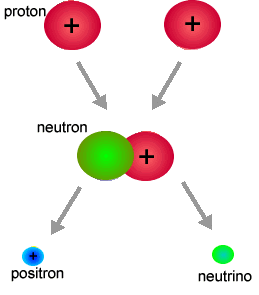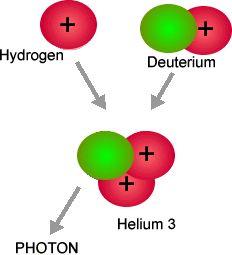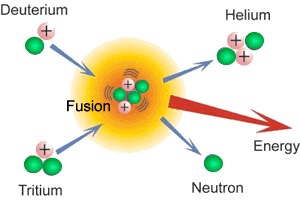|
 Fusion is the fusing together of two small nuclei to produce a bigger nucleus and release a lot of energy in the process. Fusion is the fusing together of two small nuclei to produce a bigger nucleus and release a lot of energy in the process.
 Fusion is the nuclear reaction that takes place in the stars! Fusion is the nuclear reaction that takes place in the stars!
|
 When explaining fusion to an examiner you must talk about nuclei fusing or joining together. If you talk of atoms fusing or joining you won't get the mark! When explaining fusion to an examiner you must talk about nuclei fusing or joining together. If you talk of atoms fusing or joining you won't get the mark!
 Two nuclei join to form one big one - several don't converge on each other! Two nuclei join to form one big one - several don't converge on each other!
 Fusion is not a chemical reaction, it is a nuclear one! If you call it a chemical reaction you will lose marks. Chemical reactions involve the electrons orbiting and atom. Nuclear reactions do not involve orbital electrons at all. Fusion is not a chemical reaction, it is a nuclear one! If you call it a chemical reaction you will lose marks. Chemical reactions involve the electrons orbiting and atom. Nuclear reactions do not involve orbital electrons at all.
 The singular noun is nucleus - the plural form is nuclei. Therefore you cannot have one nuclei or two nucleus! The singular noun is nucleus - the plural form is nuclei. Therefore you cannot have one nuclei or two nucleus!
|
There are many good sites that explain what happens. Take a look at this one.
The basic Hydrogen fusion cycle that occurs within a star involves four hydrogen nuclei (protons) and two electrons and yields a Helium nucleus, two neutrinos and six photons.
This process occurs in three steps:
 |
The first step is the fusion of hydrogen into deuterium (another isotope of hydrogen).
Two protons collide and one proton turns into a neutron by emitting an antielectron and a neutrino. (see the weak interaction - AS level physics)
The remaining proton is bound to the neutron forming a heavy hydrogen (deuterium) nucleus while the antielectron (the positron) will annihilate with an electron generating two high-energy gamma photons.
|
 |
The second step is the the formation of Helium-3: a proton is captured by a nucleus of deuterium emitting a photon and forming then a 3He nucleus. |
 |
The third step is recombination of two helium-3 into one nucleus of helium-4 with the emission of two protons. |
 Note that steps 1 and 2 each happen twice for each time step 3 occurs. In this process the total net energy released is about 26 MeV Note that steps 1 and 2 each happen twice for each time step 3 occurs. In this process the total net energy released is about 26 MeV
Fusion Reactors
 Here on earth, fusion research is aimed at demonstrating that this energy source can be used to produce electricity in a safe and environmentally benign way. Here on earth, fusion research is aimed at demonstrating that this energy source can be used to produce electricity in a safe and environmentally benign way.
Very high temperatures and pressures are required to overcome the repulsion between nuclei of the isotopes of hydrogen that fuse together. Once the repulsion is overcome the fused products of the nuclear reaction have a higher binding energy per nucleon (an 'A' Level study topic) than the reactants, making the reaction energetically viable and producing a release of energy.
ITER is a joint international research and development project that aims to
demonstrate the scientific and technical feasibility of fusion power.
The partners in the project - the ITER Parties - are the European Union
(represented by EURATOM), Japan, the People´s Republic of China, India, the Republic of Korea, the Russian Federation and the USA. ITER will be constructed in Europe, at Cadarache in the South of France.

Click on the cat to find nuclear fusion power in the news!
|











 Here on earth, fusion research is aimed at demonstrating that this energy source can be used to produce electricity in a safe and environmentally benign way.
Here on earth, fusion research is aimed at demonstrating that this energy source can be used to produce electricity in a safe and environmentally benign way.


